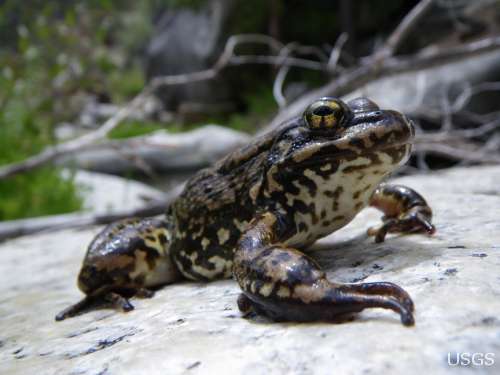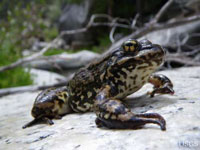104 of the animals set for release have died
The mountain yellow-legged frog, (Rana muscosa) once abundant throughout high altitude waterways of California, has experienced a several decades steep decline in numbers due to such factors as pollution, pesticide poisoning and disease. This has spurred conservation efforts started in the mid-2000s in an effort to bolster the animal's population numbers.

Photo by Adam Backlin, USGS
The mountain yellow-legged frog is listed as endangered.
The Los Angeles Times recently reported that the recovery effort at one of the zoos where a breeding program was started has been dealt a setback, as 104 sub-adult frogs have died. The zoo currently has just two frogs left and is considering sending the frogs to another facility in an effort to continue breeding the frogs. In addition to the Fresno Chaffee where the frogs perished, Los Angeles, and San Diego zoos, state and federal government agencies are working to save the frog, including The United States Geological Survey, U.S. Fish and Wildlife Service, the California Department of Fish and Game, and the U.S. Forest Service.
"This program is still in the early stages and our immediate goals are to stabilize the declines at sites the mountain yellow-legged frog still occurs naturally and to start experimenting with re-establishing mountain yellow-legged frogs to sites they historically occupied," Adam R. Backlin, ecologist with the USGS told ReptileChannel. "We are also testing the use of habitat restoration at a few sites." The efforts include releasing the egg masses as well as tadpoles. The frogs that died at the Fresno Chaffee Zoo were sub-adults ready to be released. The cause of death of the frogs has not yet been determined. Several veterinarians and amphibian pathologists are working to find out what caused the frogs to perish, Backlin said.
There have been a few other setbacks since the conservation effort began. According to the report, 36 tadpoles that were released a year ago in a stream in the San Jacinto Mountains have not been seen in any form, and in 2006, seven of the frogs died at the San Diego Zoo, victim of Chytrid, a fungal infection that is devastating frog populations throughout the world.
It is estimated that less than 200 mountain yellow-legged frogs exist in the wild. According to Backlin, care requirements of the mountain yellow-legged frog while in captivity are still a mystery. What is known is this species occupies high elevation bodies of water, hibernates in the winter months, and is very sensitive to water temperature and water chemistry, as well as disease issues.
On the positive side, the endangered frog easily reproduces in captivity. "These frogs are great animals for captive reproduction as they can produce up to 200 eggs in a single clutch, so we have the potential to produce many new animals in a short period of time for re-establishment," Backlin said.
The mountain yellow-legged frog is around three inches in length and lives in high elevation lakes, ponds, streams, and pools of water in California. It hibernates in the winter months. The frog lays eggs in the spring and the tadpoles arrive approximately two months later and remain as tadpoles throughout the summer, winter, and following spring. They then start to metamorphose into frogs the following summer and fall. As adults, they can live 10-15 years.



